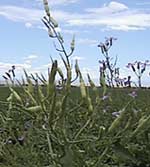Resources - Pests |
Nematode Control
|
Table of ContentsMore Information:
|
1. IntroductionNematodes in Sugar Beets, Potatoes and other Root Crops Frequent cropping of land with root crops like sugar beets, may lead to nematode infestations which stunt the plants and greatly reduce yields. In sugar beets, this condition is caused by the beet cyst nematode (or beet eelworm), a common pest in the USA and Europe. The sugar beet rootlets play host to the nematodes, and when numbers build up, serious yield losses can occur. There are many different types of nematodes, and crops that are effected by them include potatoes, carrots, cabbage, cauliflower and broccoli. Cereals and vine crops can also be infected, especially by the migratory stubby root and root lesion nematodes. After root knot nematodes have infected the host plant, Verticilium, Rhizoctonia and Fusarium fungi which might be present in the soil can then cause severe root rot damage.
2. Controlling Nematodes with Trap CropsOne of the simplest and most cost-effective ways of controlling nematodes is through the use of crop rotations to break the growth cycle. Crucifers crops have a good reputation for rotating with cereals, sugar beets and potatoes. They have deep taproots, which break up plow pans, improve soil tilth and they are a good supplier of organic matter. Historically, Mustards and Radishes have been good hosts of nematodes, - particularly the beet cyst nematode – so their use in a rotation can aggravate a nematode problem. However, sophisticated plant breeding has now led to the development of new varieties that, although they attract them, are unsuitable hosts for the beet cyst nematode (and others). Cultivation of these varieties can lead to a significant reduction in the population of beet cyst nematodes. In Europe, use of the trap crops has resulted in an increase in sugar beet yields up to 33%, and an increase in sugar content of 8%. By inserting the trap crops into the rotation, the levels of nematodes have been reduced between 40 and 75%, if the crops are established at a favorable time for the nematodes to hatch (optimum temperature is 69/70°F).
3. How Trap Crops WorkThe trap crops are special and unique varieties of white mustard and fodder radish. The roots of the trap crops produce chemicals that stimulate the hatching of the nematode cysts in the soil. Once the nematodes hatch, they migrate to the growing roots of the trap crops. Once inside the roots, the nematodes start to feed. However, the trap crops have been bred to provide the nematode with inadequate nutrition to mature, and the reproductive cycle is broken. A further reduction of the number of beet cyst nematodes appears by a stimulation of parasites that attack the nematodes. Decomposed trap crops stimulate the development of saprophytic fungi that invade the cyst, and parasitize the eggs and nematodes within the cyst. The use of trap crops will thus lower the incidence of the root knot nematodes and the stubby root nematodes.
4. ApplicationTrap crops can either be sown as a normal spring seeded rotational crop, or can be sown after a crop is harvested in July or August. Best results will likely occur if the trap crops are seeded in the spring, but late summer crops are also effective. The trap crops are not winter hardy, and will be killed by frost. If the trap crops are planted in the spring, they will need to be cut or green manured before the seed matures, to prevent volunteer growth. Rapid regrowth will occur following cutting. Trap crops should be seeded shallow (1/2") at 20-25 lbs/acre. They will establish very quickly and can be effective in smothering weeds.
*Mustard is very fast growing and should not be sown before August 10, unless the crop is cut or flailed before seeds become viable.
If you are interested in some varieties for evaluation, contact Holly Hybrids or your local agriculturist/ field representative.
|
